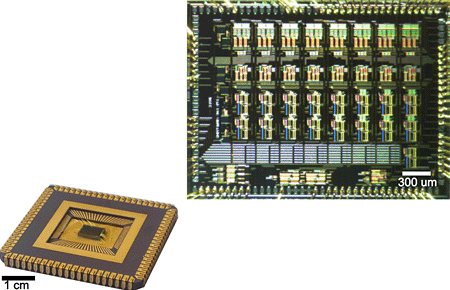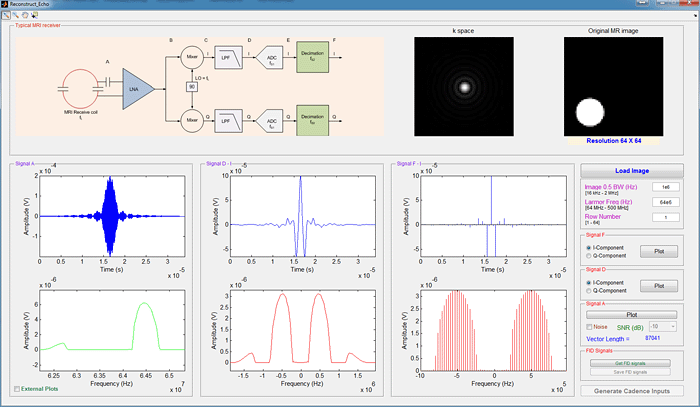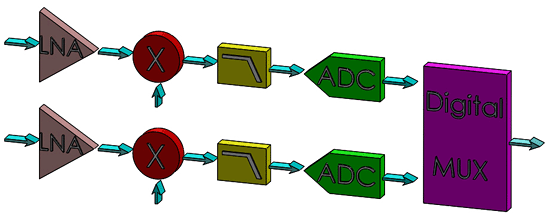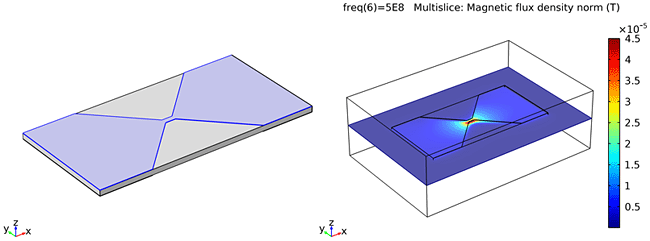CMOS frequency division multiplexer for Parallel MRI
This project demonstrates the design and characterization of a CMOS 8-channel Frequency Division Multiplexer (FDM) as a promising miniaturized and fully integrated solution to the size, cost, and complexity drawbacks associated with Magnetic Resonance Imaging (MRI) detection arrays. The literature shows that the use of these detection arrays significantly enhances the MR imaging resolution, reduces the imaging time, and enlarging the imaging Field of View (FoV). However, incorporating more detectors to the MR array increases the size and complexity of the system tremendously.
Contact

Fig1: Photograph of a micro-chip designed and fabricated using 350 nm high-quality CMOS technology.
The chip comprises an 8-channel frequency division multiplexer for parallel MRI.
Matlab toolbox for MRI hardware design
We developed a Matlab toolbox that comprises several programs with graphical user interface (GUI). The novel toolbox allows the MRI hardware designers to verify their circuits by performing a virtual MR imaging experiment that mimics a real imaging procedure, and thus saves significantly the cost and time.
Contact

Fig2: Matlab toolbox to test and characterize the MRI hardware in the context of virtual MR imaging experiment.
MRI digital time division multiplexing
The increasing demand for higher resolution and faster MR imaging raises the need to involve more MR detectors which, in turn, boosts the necessity for more efficient solutions to the cost and size problems resulting from increased numbers of detectors. A good example of such solutions is the CMOS digital time division multiplexer shown in figure 3.
Contact

Fig3: Schematic diagram of a CMOS fully integrated MR receiver that allows digital time division multiplexing.
MR detector optimization
Current research focuses on the design and optimization of RF detectors for high sensitivity and small sample volume. Such detectors include wideband and narrow band, single-channel and multi-channel detectors, planar spiral coils and stripline resonators.
Contact

Fig4: A finite element simulation of the magnetic flux density of a stripline NMR detector.
Besides the NMR detector design, the current research includes also developing methods to enhance the sensitivity of the NMR detectors. Such methods comprise, for example, the use of magnetic lenses (known also as Lenz lenses) to focus and concentrate the magnetic field of the detector in the sample’s region.
Portable magnetic resonance spectroscopy
The work developed by the group is in the field of portable magnetic resonance spectroscopy, for use in non-conventional applications.
Current activities encompass the development of a fully application-specific spectrometer, for improved performance. This requires the reworking of magnetic field generation and correction, or shimming, the encoding and transceiving antennas/coil as well as the processing electronics. These pose new challenges, compared to conventional NMR, due to the low target cost range and different application specific constraints.
The final application will be to measure liquid flow in a mm-sized tube without disturbing or contaminating the flow. The non-invasive nature of this approach introduces however many challenges due to the variable conditions of temperature, pressure, NMR-sensitive species and fluid composition.

Fig5: Permanent portable magnet based on the Halbach structure with a flexible MR detector.
Versatile NMR/MRI measurement tools
Sensor systems for ultra-high-field NMR/MRI applications are designed for specific measurement tasks such as liquid-state NMR or solid-state NMR. Optimisation of these sensors is realized with respect to their NMR/MRI performance such that they have e.g. multiple RF channels, high quality factor sensors to obtain high SNR, fast gradient systems etc. From the viewpoint of the research object there is an increasing demand to manipulate or stimulate the specimen simultaneously during the acquisition process. The manipulation process depends on the specimen and the desired task. As an example, biologicals samples, if kept alive, have to be provided with the essential nutrients while keeping the proper temperature. Further increasing demand is found in the combination of different acquisition techniques such as calorimetry and NMR where we need to trigger a chemical reaction and measure the temperature increase simultaneously to the NMR signal. Our research is targeted on the combination of various measurement techniques with NMR to expand the available signals and to enhance the possible study conditions for wide range of analysis.

Fig6: Display of different acquisition techniques and sample treatment opportunities that are considered to combine with NMR/MRI. Right: Example of a single channel MR Probehead.

